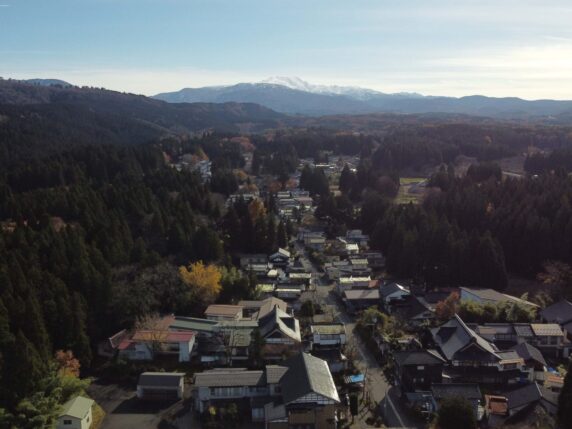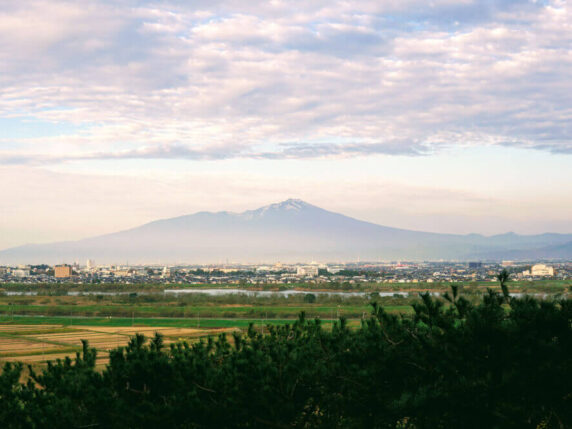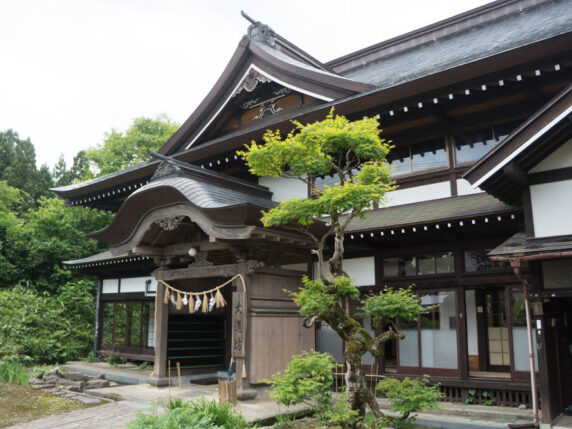The Shoreisai Festival on Mt. Haguro
Written by Timothy Bunting
What better way to welcome in the new year than with the symbolic burning of an evil demon to a crisp? Well, the annihilation of a demon twice is all but one small part of the much larger Shoreisai festival that starts with the most gruelling of Yamabushi rituals on the Dewa Sanzan, the Fuyunomine Winter Peak Ritual. Learn more as we dive deep into the story behind two of the most important events on the Dewa Sanzan calendar.
Peak Rituals on the Dewa Sanzan
Before I tell you about the Shoreisai Festival, you have to know about the peak rituals on the Dewa Sanzan. Since ancient times, Yamabushi mountain monks on the Dewa Sanzan have taken part in what are called ‘Mineiri’ (lit. mountain entry) rituals known in English as the peak rituals. There is, or was, a peak ritual for each of the seasons, the Harunomine Spring Peak, the Natsunomine Summer Peak, the Akinomine Autumn Peak, and last, the Fuyunomine Winter Peak.
The most well-known of the peak rituals is the Akinomine Autumn Peak Ritual at the end of August, of which there are actually two: a Buddhist version and a Shinto version run by Kotakuji Temple and Dewa Sanzan Shrine respectively. The Akinomine Autumn Peak Ritual concludes with the Hassaku Festival on August 31st. The Natsunomine Summer Peak Ritual now only truly survives as the Dewa Sanzan Flower Festival on July 15, and the Harunomine Spring Peak Ritual was only recently restarted after a 150-year hiatus.
Well, of the four peak rituals, the Fuyunomine Winter Peak Ritual is arguably the most demanding. In this ancient ritual, two senior Yamabushi called Matsuhijiri spend 100 solitary days praying for a good harvest in the coming year. While that might not seem like much fun for us, the general public, I assure you you’re going to want to be there at the Shoreisai Festival at its conclusion on New Year’s Eve. So, let's take a look at how the Fuyunomine originated, and what exactly happens.
The Fuyunomine Winter Peak Ritual
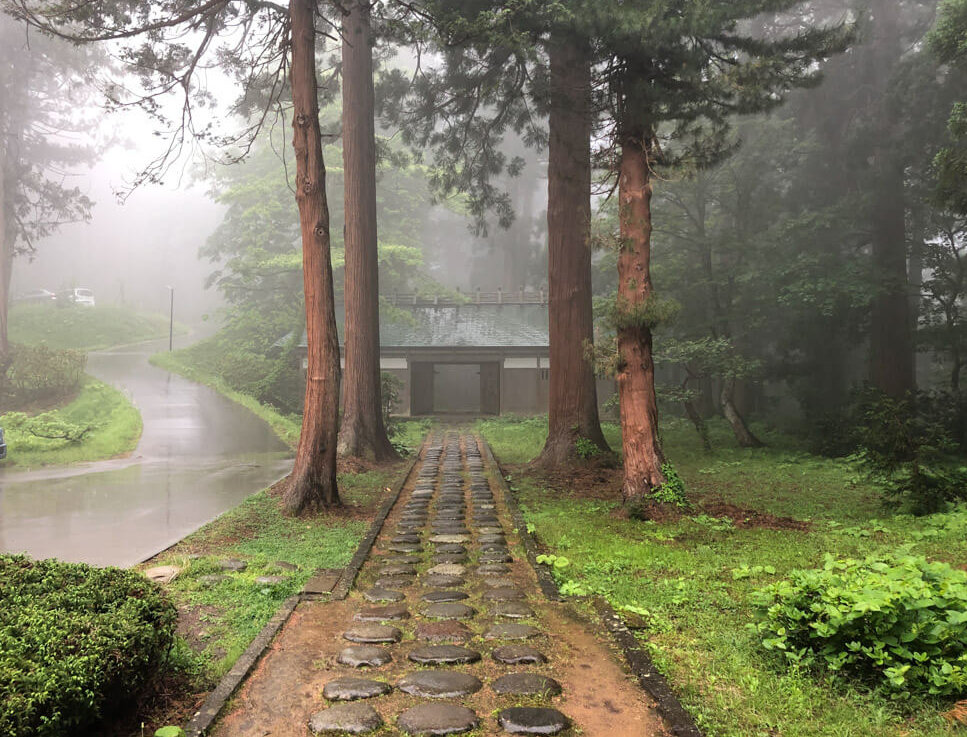
In ancient times, people were unsure where their next meal would come from. This was especially true in a country where natural disasters such as earthquakes, tsunami, drought, and in turn famine, were a common occurrence. For the people of Shonai, agriculture has been a core component of life for centuries. The region has relied heavily on the rice, fruit, and vegetables they produce not only for income, but also for survival. Therefore, it’s only natural that prayers and rituals dedicated to the gods of agriculture began, and the Fuyunomine ritual is essentially that, an extensive prayer for a good harvest in the following year.
Enter the Matsuhijiri Priests
While preparations for the Fuyunomine Ritual truly begin in the middle of June, it’s not until the middle of August that they choose the two Matsuhijiri priests, the highest-ranking Yamabushi priests in Haguro Shugendo. The Matsuhijiri priests must be living in the Toge region surrounding Mt. Haguro. The eldest is designated the Ijo Matsuhijiri (lit. upper-rank), the youngest the Sendo Matsuhijiri (lit. prospect). Following the Heitate festival at Saikan on the 24th of September, the Matsuhijiri begin 100 days secluded in worship when they are forbidden to eat meat or fish, or to even shave. Those who know master Hoshino of Daishobo Pilgrim Lodge now know where he got his awesome beard from.
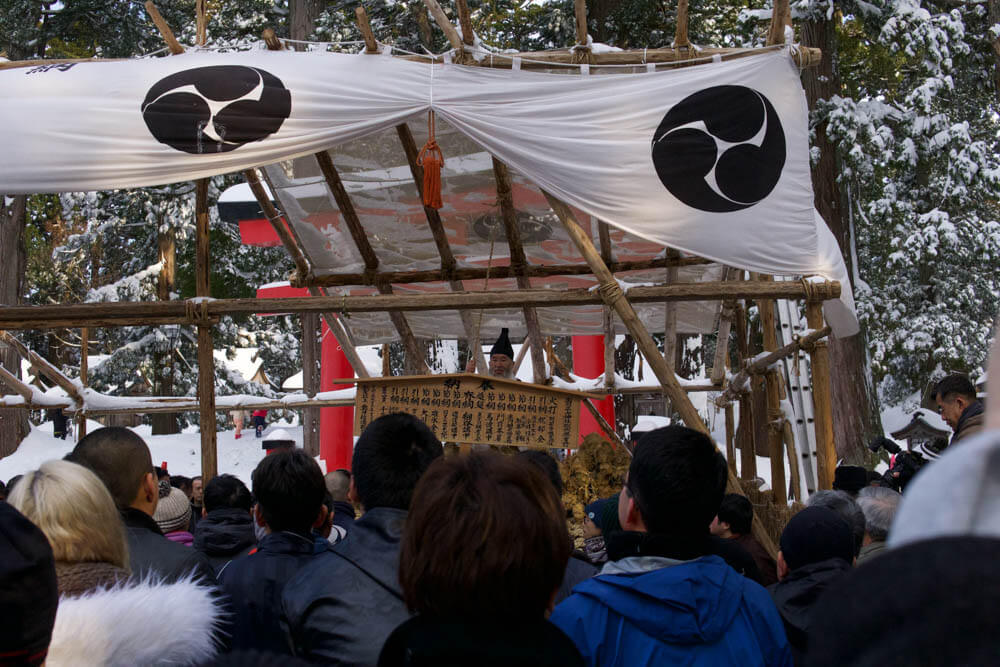
The Matsuhijiri spend the first 50 days of the Fuyunomine Ritual in their respective homes, but move to a special room in Saikan for the final 50 days from the 13th of November. This is also when the Matsu-no-kanjin begins; flanked by priests of Dewa Sanzan Shrine and Yamabushi from the Shukubo, the Matsuhijiri travel all around the Shonai region collecting donations for the festival.
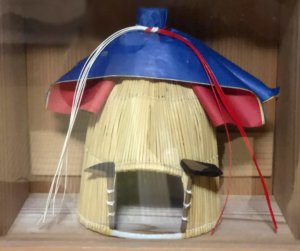
During the 100 days, the Matsuhijiri pray twice daily to five grains in a small hut, called a Koyahijiri, that is equipped with a hoe and scythe. The Matsuhijiri pray for peace of the land, security of the nation, a bumper crop, the submission of evil spirits, the health and safety of the households, and granting of wishes of those that call the Shonai region home. The Fuyunomine Ritual concludes on New Year’s Eve with the Shoreisai Festival.
What Happens at The Shoreisai Festival?
Essentially, the Shoreisai Festival is a giant competition between the two Matsuhijiri to find out who gained the superior skills during the Fuyunomine Ritual. At the start of the Shoreisai Festival, the townspeople are split into two teams; the Ijogata for the Ijo Matsuhijiri, and the Sendogata for the Sendo Matsuhijiri. Then, the teams compete against each other in a number of challenges to determine the winner, such as the ceremonious destruction of a giant demon. The belief here is that if the Ijogata win, the following year will be a good for fisheries, and if the Sendogata win, there will be a good harvest.
Shoreisai Festival Schedule
| Time | Event | Location |
| 15:00 | Tsunamaki Throwing of the rope | Main Field |
| 17:00 | Prayers to the gods | Shitsuraeya Huts |
| 18:00 | Marukinaoshi Chopping up of Soranki | Main Field |
| 19:00 | Tsuna Sabaki Leaders' Debate | Shitsuraeya Huts |
| 20:30 | Ken'nawa Measuring of the Field and Sunahaki Watashi Passing of the Spade Ceremony | Shitsuraeya Huts |
| 21:00 | Sunahaki Spade Ceremony | Main Field |
| 21:30 | Genkurabe Ascetic Feats Practice | Sanjingosaiden Shrine Hall |
| 22:45 | Genkurabe Ascetic Feats Performance | Sanjingosaiden Shrine Hall |
| 23:00 (after conch) | Otaimatsuhiki Pulling of the Giant Effigy | Main Field |
| 12:00am | Kuniwake and other Fire Ceremonies | Main Field |
| 1:00am (approx.) | Announcement of Results | Sanjingosaiden |
| 3:00am | New Year's Official Prayer | Sanjingosaiden Shrine Hall |
Preparations Begin
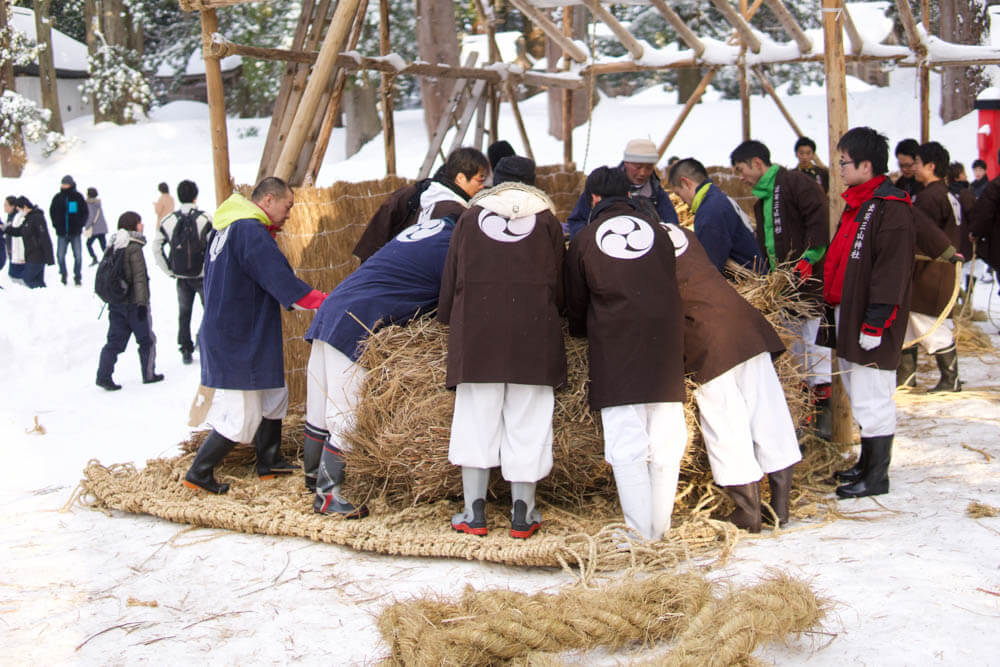
The younger generations from Toge hike up a snow-covered Mt. Haguro on the morning of the 30th of December. Once there, they split into the two teams supporting each Matsuhijiri depending on which of the eight areas of Toge they are from. Then, each team gets to work creating their own Otaimatsu (giant straw effigy) modelled on harvest mites and resembling the evil demon Soranki. From that point on, it’s a competition of superiority between the two Matsuhijiri.
Soranki: The Fiery Demon
According to legend, hundreds of years ago an extremely strong demon named Soranki was wreaking havoc on the townspeople. Lightning and fire rained down on the lands, destroying crops, and causing widespread famine. The townspeople were suffering, and no one knew what to do. Until of course Prince Hachiko, the founder of the Dewa Sanzan, came to the fore. Prince Hachiko performed a ceremonious burning of an effigy of Soranki, and they had slayed demon once and for all, or so they thought. Soranki is said to be so powerful he comes back every year. The main event for many at the Shoreisai Festival is the Otaimatsuhiki, a giant straw effigy of Soranki, called and Otaimatsu, is killed by being split in two, set alight, and dragged across a field at the top of Mt. Haguro.
The Competition Begins

The first challenge of the Shoreisai Festival starts at 4pm on the 30th and is called the Matsu no Rei (lit. the pine fan). Across the field from the Otaimatsu effigy are two wooden poles called Taihei, with each Taihei representing a different team. The area closest to Sanjingosaiden Shrine represents the Sendogata team, and the area furthest away the Ijogata team. Then, once each Matsuhijiri finishes a curse on the Otaimatsu effigy, a representative from each team named the Matsu’uchi carries a fan and runs full speed to their team’s Taihei pole. It’s a race to see which team can raise their fan on the Taihei pole the fastest.
Awaiting the Matsuhijiri at The Shitsuraeya
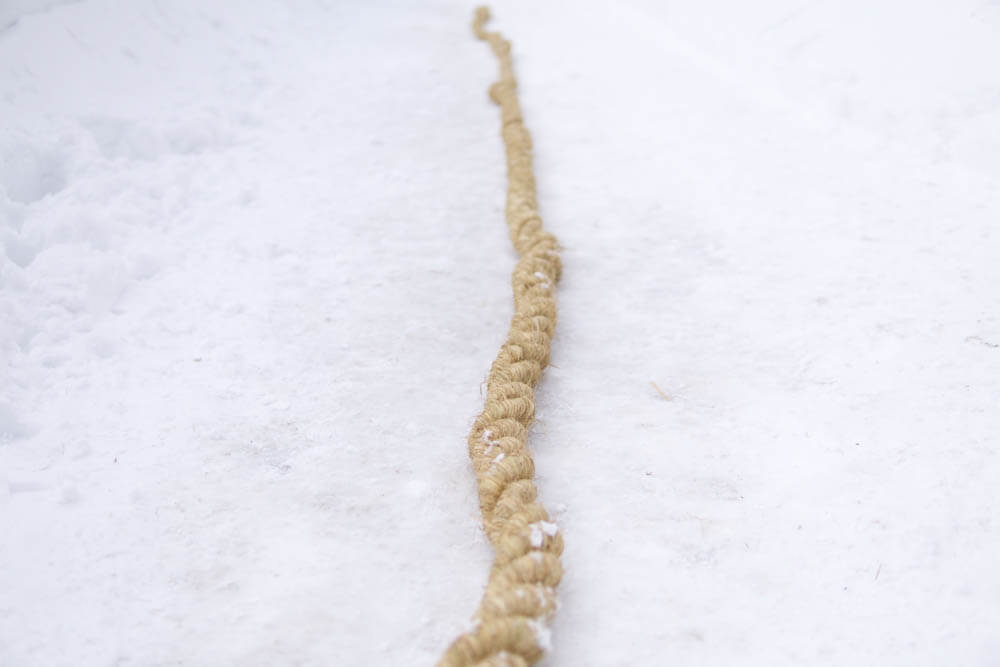
The next day is New Year’s Eve, and from 9am the younger generations start clearing the snow to the Shitsuraeya Huts to welcome in the Matsuhijiri from 11am. This is where the Matsuhijiri will be during breaks from ceremonies at the Shoreisai Festival. For those who want a bit of refreshment, from 10:30am onwards celebratory sake and Oyadama rice balls sprinkled with seeds of the summer cypress are on offer to all.
Tsunamaki: Throwing of the Rope
Then from 3pm, there is the Tsunamaki (throwing of rope) ceremony on the ceremonial grounds next to the Kagami’ike pond in front of Sanjingosaiden. Here, both Matsuhijiri slice up the Otaimatsu effigy, representing Soranki, into smaller mounds of rope and throw them out into the crowd. The mounds are said to represent harvest mites used for protection, so those lucky enough to grab one decorate it in the entrance to their house to ward off evil. It is believed that by doing so, any evil that tries to approach their house gets cut down just like the rope has been. If you snatch one of these mounds at the same time as someone else, then it’s time to sumo wrestle for it! Didn’t manage to get one when they were throwing them out? Don’t worry, you’ll also be given the chance to sumo wrestle for one.
Marukinaoshi: Soranki Returns
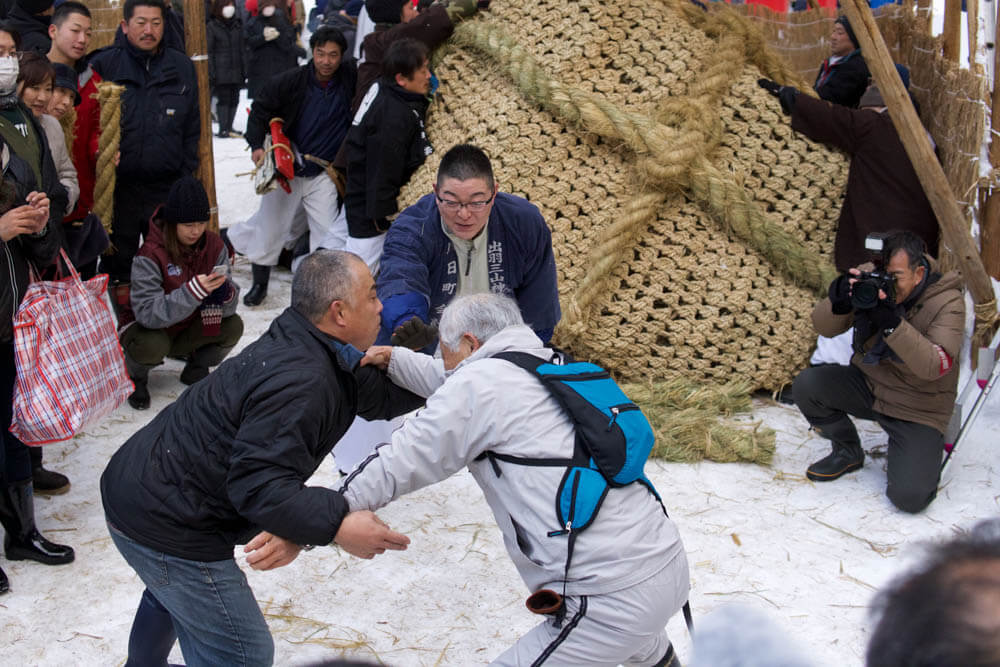
Thought that was the end for our demon friend? Think again. Soranki is so strong that he returns even after being sliced up and spread amongst the townspeople. From 6pm is the Marukinaoshi ceremony, where the demon is chopped up and wrapped in bamboo leaves and reeds, making it about half the original size.
Tsuna Sabaki and Sunahiki Watashi: The Drunken Debate and Passing of the Spade

If you ever needed an excuse to get drunk, how’s this? From 7pm at the Shitsuraeya, the leaders have a drunken debate over who is the most worthy of pulling which of the four ropes for each team. Called the Tsuna Sabaki (judgment of the rope), the ceremony lasts more than an hour, and more than a dozen bottles of the region’s finest. Some of the ropes are in more advantageous positions, hence the debate always gets heated, and the sake always flows.
Sunahaki Watashi: Passing of the Spade
From 8:30, after the Tsuna Sabaki ceremony finishes, it’s time for the Sunahaki Watashi (Passing of the Spade) ceremony. In this ceremony, the Matsuhijiri bless their team members and tools for clearing the snow such as a special spade (Sunahiki), in preparation for the Otaimatsuhiki (effigy-pulling) Race. Two people of each of the eight towns at the base of Mt. Haguro are chosen for this, four from Ijogata and four from Sendogata. One person is designated the Tsunanobe, the person in charge of putting the rope in front of the houses for that year. Another person is designated the Tsunadzuke, the person in charge of putting the rope in front of the house in the following year.
Ken’nawa: Measuring of the field
From 9pm, ceremonial spades in hand, all the Tsunanobe and Tsunadzuke head to the Otaimatsu out on the field. Their job? Measure out 33 Jin (lengths of a wooden pole) from the two Taihei poles from the previous day. 33 refers to the number of provinces in Mt. Haguro’s territory, and this measuring is to confirm that the burning takes place outside the territories. Once measured, the Tsunanobe from each team use the ceremonial spade to dig a hole around the pole that the Otaimatsu effigy will be burned in. The Tsunadzuke guard to make sure the spade isn’t stolen. When finished, everyone runs back to the Shitsuraeya for the Gojomoku (rule announcement) ceremony. Here a prayer is read to ensure everyone is following the rules.
Genkurabe: Ascetic Feats Rehearsal
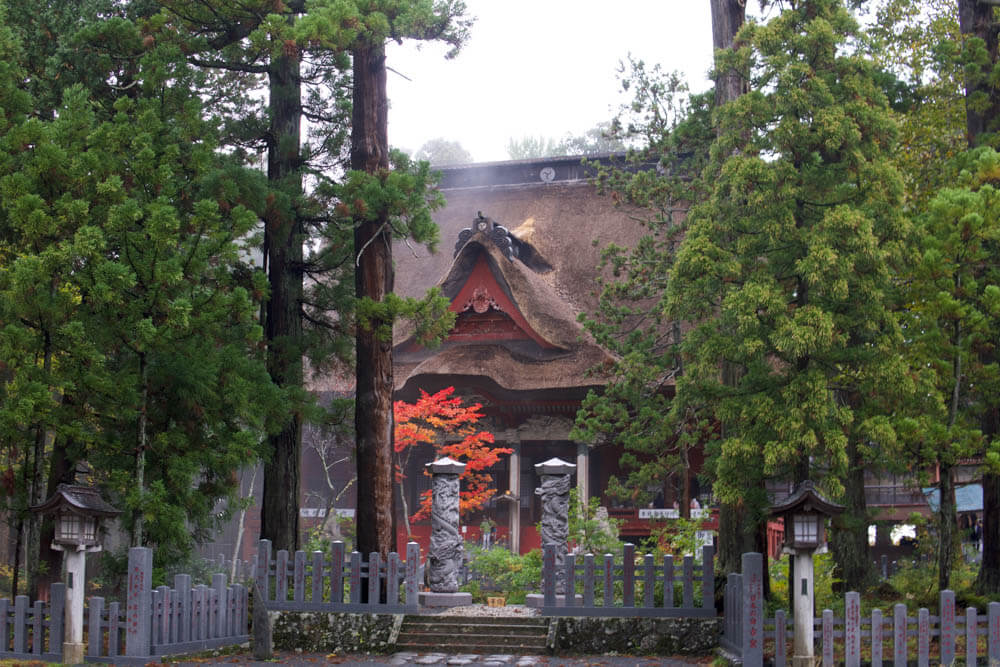
The main event for the Matsuhijiri, called the Genkurabe (lit. ascetic feats comparison) begins from 10:30, and right after that is the Otaimatsu race. It’s not possible to see both during this time, but fortunately if you want to see both there is a rehearsal for the Genkurabe ceremony from 9:30 at Sanjingosaiden Shrine.
Genkurabe: Ascetic Feats Performance
From 10:45 it’s time for the culmination of 100 days’ training for the Matsuhijiri with the Genkurabe proper. Six Yamabushi represent each of the Matsuhijiri, one Yamabushi for each month, lining up east to west in front of the gods in the inner sanctum of Sanjingosaiden Shrine. One by one, the six Yamabushi from each team imitate a jumping crow. Crows are a reincarnation of the sun and symbolizing Yang. Then a person dressed as a hare, a reincarnation of the moon, symbolizing Ying, awaits their cue and sits in between two tables in the middle of the room.
Then the judges call upon the six Yamabushi who take turns to hit their fans against a table. Based on the sound, the hare then places their hand on one of the tables to declare the winner. Once the fifth Yamabushi of each team has finished, a signal is made to the Horagai conch player, who blows their conch fives times. The fifth person of six represents midsummer, and the five conch blows represent driving winter away.
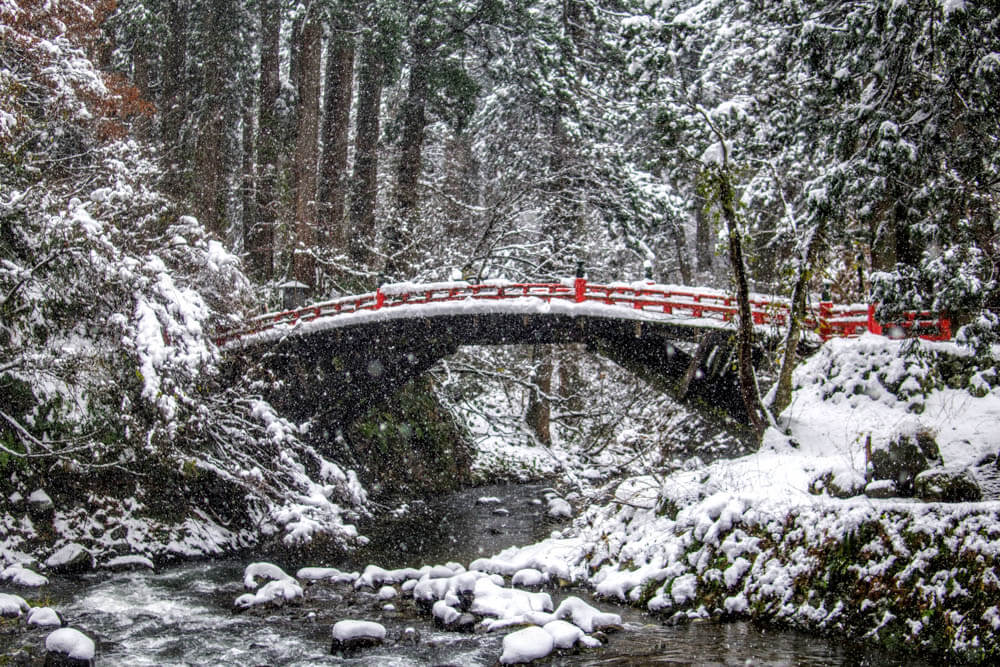
Otaimatsuhiki: Pulling of the Giant Effigy
The conch is the cue for the people on the field to start the Otaimatsuhiki Effigy Race. Here 40 or so members from each team pull a flaming Soranki across the field using the long ropes. The objective? Stand the Otaimatsu against the Taihei poles from earlier, and burn them down to the ground. Whichever team’s effigy burns better is declared the winner. This is the final end for our fiery friend for this year, but make no mistake, he will be back for more in the coming years.
Fire-Passing Ceremony Part One: The Kuniwake Ceremony
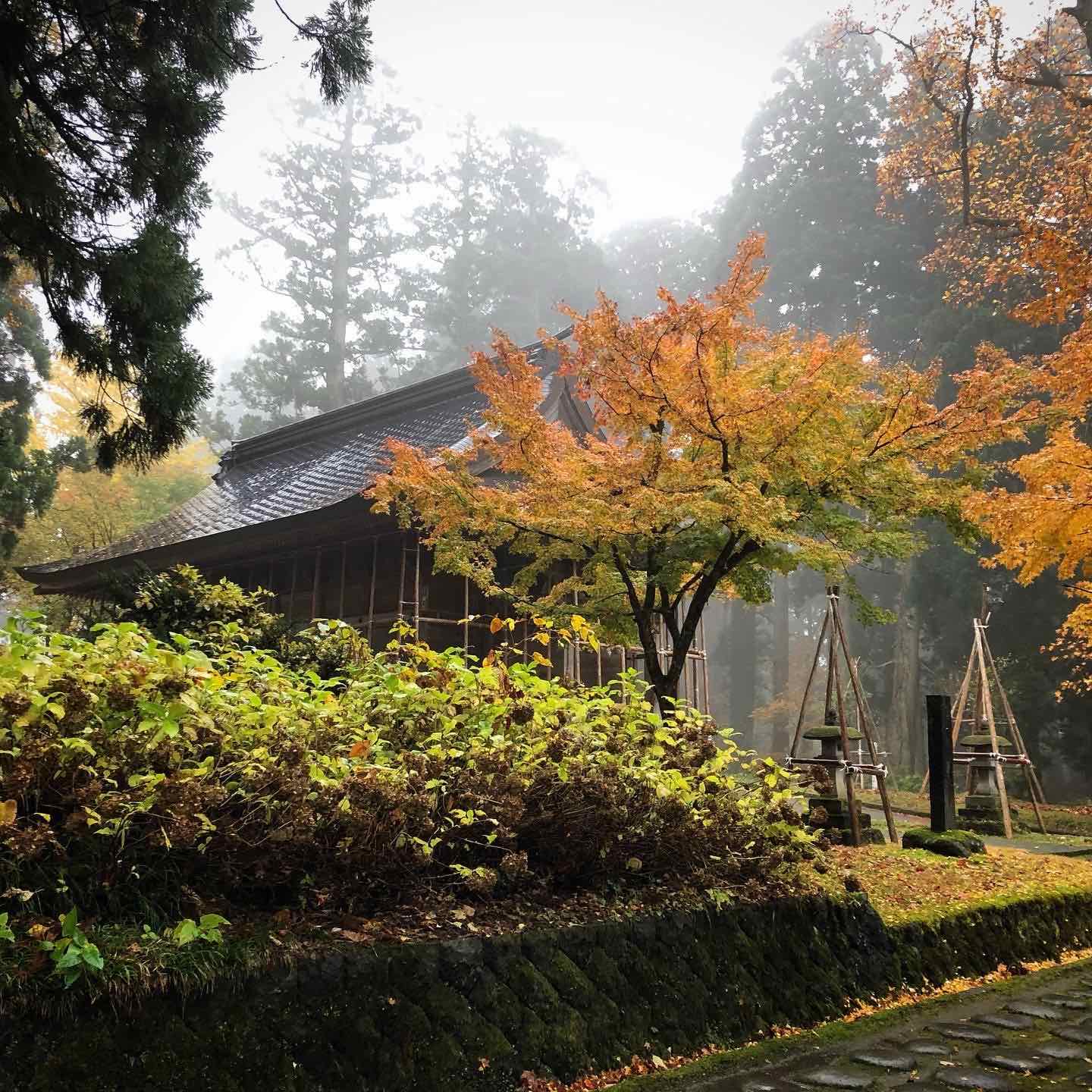
From 12am, it’s time for the Kuniwake Ceremony: the confirmation of the ascetic territories. During this ceremony, a straw mound called a Kagami Taimatsu is lit while waiting for Otoshinokami, the god of agriculture. Then, four Haguro Yamabushi, three representing Kumano in western Japan, and one representing Mt. Hiko in Kyushu, perform with the Shoshimae, a priest representing the gods.
The Shoshimae and top Yamabushi take the pole earlier used to measure the field and repeatedly push it back and forth to check the distance of the field is the correct 33 Jin. Doing this twice for a total of 66 times represents the 33 territories of Mt. Haguro, the 24 territories of Kumano, and the 9 territories of Mt. Hiko.
Fire-Passing Ceremony Part Two: The Taimatsu Ceremony
Once the territories have been confirmed in the Kuniwake ceremony, the Taimatsu ceremony begins using flames from the Kagami Taimatsu (torch. Because the Kagami Torch fire weakens it is said to become impure, and a new pure fire full of vigour is taken out of it by the four Yamabushi. Then the two Matsu’uchi representatives for each Matsuhijiri carry a fire starter and striker, run between the four Yamabushi, run around the Kagami Taimatsu three times, then run to two people holding torches near the burning Soranki. The first team to light their torch is the winner.
Announcement of the Results
Once this is done, everyone returns to Sanjingosaiden Shrine for the judges to announce the winners of the Otaimatsuhiki and the fire-passing ceremonies to the head priest, who then announces the grand winner. A win for the Ijogata means a good year for the harvest, and a win for the Sendogata means a good year for fisheries. Following this, the results are announced to the Matsuhijiri waiting in the Shitsuraeya. The Matsuhijiri take the seeds they prayed to for 100 days, that are now possessed with the god of agriculture, and sprinkle them throughout the Shitsuraeya huts. The huts are said to represent the territories of Mt. Haguro, and sprinkling the grains like this symbolises sprinkling seeds possessed with the god of agriculture all throughout.
Getting to the Shoreisai Festival
As the Shoreisai takes place at the top of Mt. Haguro, it is not exactly easy to access, especially in winter. The best thing to do would be to stay in Saikan at the top, which we can help you arrange (email us at info@dewasanzan.com). In saying that, the best way to get there is by private car using the ¥400 toll road. If you get there late, you might have to park in the third car park, but don't worry, there is a shuttle bus from the third carpark to the main carpark. We'd recommend getting there around 2:30 if you want to see everything and be there for the Tsunamaki Rope Throwing Ceremony, or around 7 if you want to get there when the action starts in full force.
Shoreisai Festival Busses
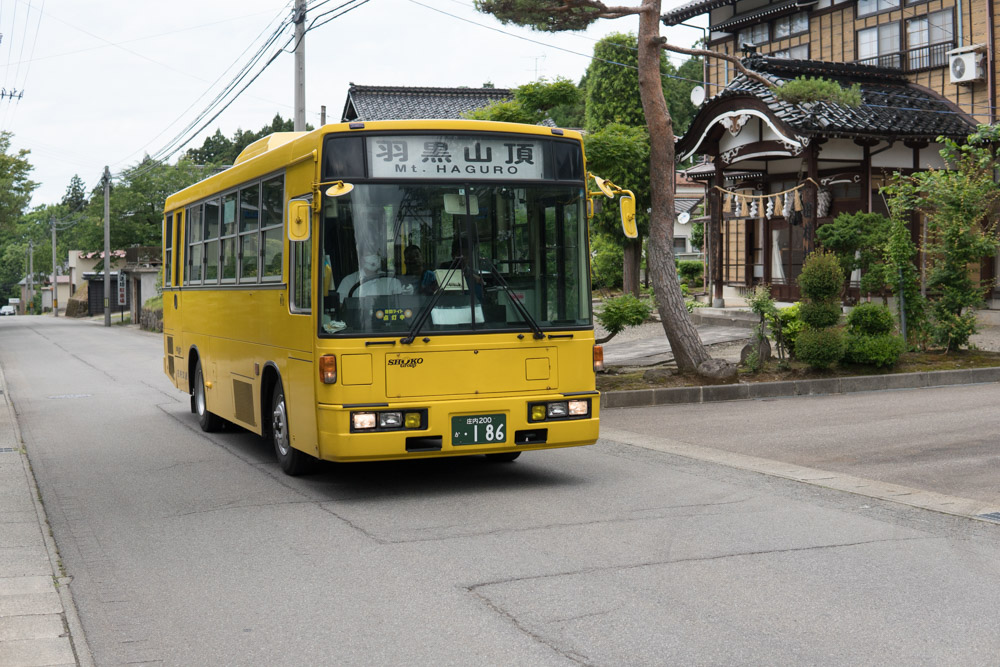
If you don’t have a car, the only way to get there is by public bus or taxi. There are two busses from S-Mall and Tsuruoka Station at the times below*. There are also two return busses from the top of Mt. Haguro, one at 1am, the other at 7am. More details can be found in our comprehensive guide to accessing the Dewa Sanzan.
Busses from Tsuruoka to the Shoreisai Festival*
| Bus stop | Time | Time |
| S-Mall | 18:35 | 21:40 |
| Tsuruoka Station | 18:37 | 21:42 |
| Sakura Koji (Daishinbo, Daishobo) | 19:12 | 22:15 |
| Zuishinmon (base of Mt. Haguro) | 19:15 | 22:15 |
| Top of Mt. Haguro | 19:30 | 22:35 |
Busses from the Shoreisai Festival back to Tsuruoka*
| Bus stop | Time | Time |
| Top of Mt. Haguro | 1:00am | 7:00am |
| Zuishinmon (base of Mt. Haguro) | 1:15 | 7:15 |
| Sakura Koji (Daishinbo, Daishobo) | 1:16 | 7:16 |
| Tsuruoka Station | 1:50 | 7:50 |
| S-Mall | 1:52 | 7:52 |
*This timetable is from the 2018-19 festival and may not be accurate. Make sure you check in advance (you can email us at info@dewasanzan.com).
Accommodation during the Shoreisai Festival

Many of the Shukubo at the base of Mt. Haguro may be closed for the winter. Your best bet would be to stay at Saikan, or somewhere like Tamonkan. As Saikan is at the top of Mt. Haguro already, this puts you in an excellent spot for the Shoreisai festival. It's also a great chance to try Dewa Sanzan Shojin Ryori. Send us an email at info@dewasanzan.com and we can organise your stay.
Other things to check out
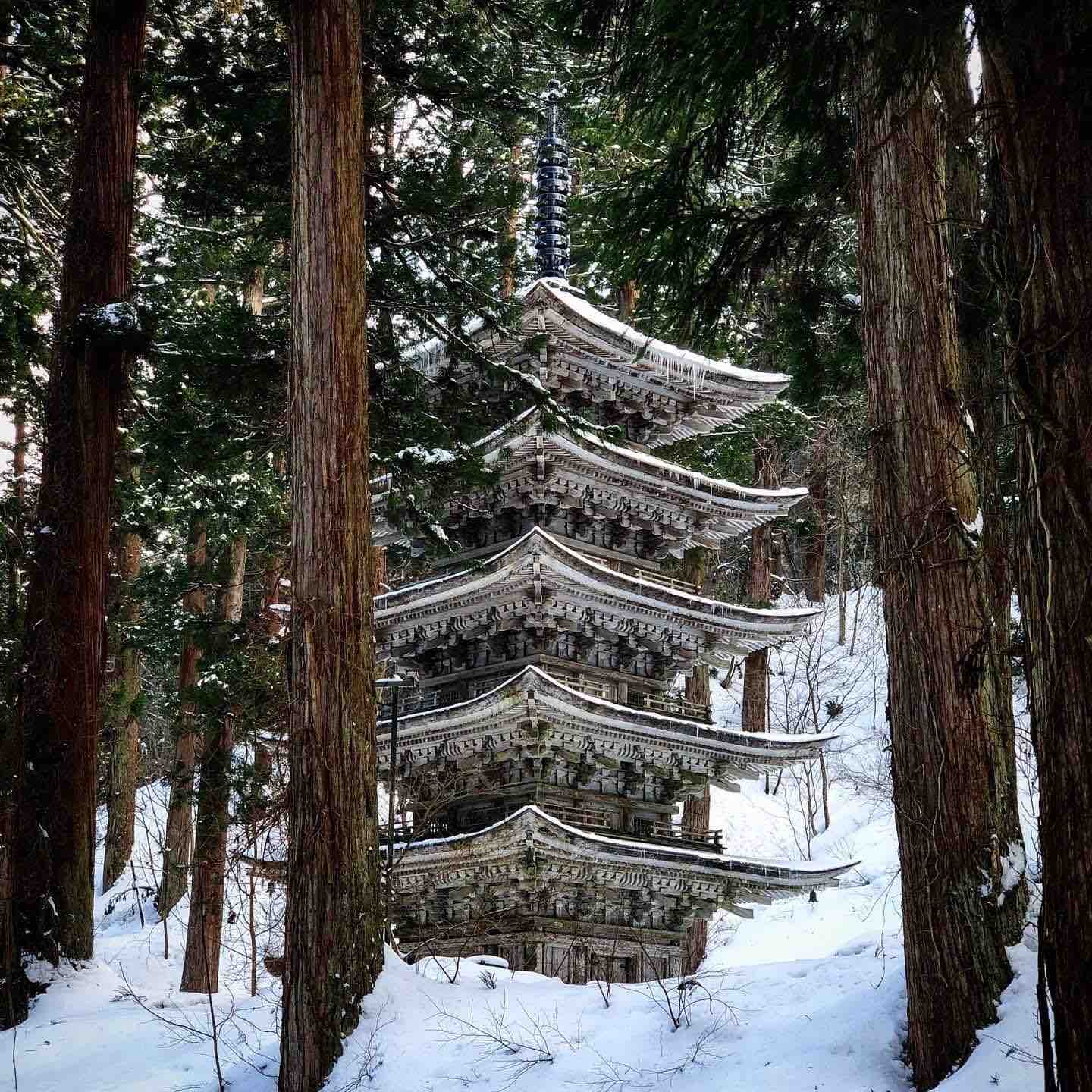
As it is winter, Mt. Gassan and Mt. Yudono are both closed, but there is still plenty to do in the area. While you’re here, be sure to check out the Five Story Pagoda at the base of Mt. Haguro. Snow shoes or rain boots can be borrowed from the Ideha Cultural Museum near the Zuishinmon gates. Although you can't stay in Saikan on the night, they do take in bookings around this time for both accommodation and Shojin Ryori meals.
References:
This article was written with help from this website (Japanese) on the Shoreisai festival itself, and the Dewa Sanzan Shrine website (Japanese), as well as this article on the Four Peak Rituals on the Dewa Sanzan (also Japanese).
Timothy Bunting
Tim Bunting is a Dewa Sanzan Shrine Yamabushi with over 10 years' experience living beneath the three mystical peaks. He is a self-professed Dewa Sanzan nerd, and is currently working on the Yamabushido project and Dewa Sanzan Monzenmachi Project with Megurun Inc. His roles including assisting in Yamabushi trainings, translating, interpreting, and curating Dewasanzan.com.
Insider information and updates on
The Dewa Sanzan.
Subscribe to the Dewa Sanzan Tribe now.

